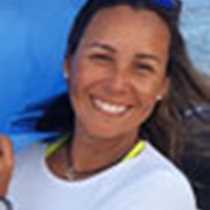Floreana Island
This is our third day into our wonderful expedition in the Galápagos Islands, and today we dropped anchor early in the morning at Punta Cormorant, north of Floreana. This is an island of extreme beauty, with its hilly outline and serene landscapes all around. Before breakfast, we landed at a greenish-tinged beach; its color is due to its sands being mainly composed of miniature olivine crystals. Behind the beach there is a large brackish lagoon. These waters contain miniature crustaceans and algae, which make an important part of the diet of the resident population of flamingos. A black-necked common stilt was also feeding off these brackish waters. The end of the trail leads us to a stunning white beach, and its white sands are composed of calcium carbonate or the pulverized skeletons of marine organisms that have been previously eaten up by parrotfish, sea stars, and other predators. This white beach happens to be an important egg-laying site for the Pacific green sea turtle, our resident turtle species. High up on the beach we spotted a female still working hard at nesting. She has not been the only one, as we found fresh turtle tracks along this very same beach.
After breakfast, we had a chance to find more unique species at a small islet nearby called Champion. This is one of the last habitats of an endemic land bird species called the Floreana mockingbird. Back when Charles Darwin visited this island in 1835 the then-called “mocking-thrushes” were very abundant, but due to modifications of the habitat and the introduction of new predatory species their population seriously declined. Today we were successful at spotting a few Floreana mockingbirds around the prickly pears of the island. Along the shores of Champion we saw other unique species like the swallow-tailed gull, brown noddy terns, blue-footed boobies and the ever-popular Galápagos sea lion. And wow, they were really playful at the time when we went snorkeling! Daring and curious as usual, we were constantly accompanied by these sea lions…an experience we are never to forget.
There was a short navigation by midday, and the National Geographic Islander had to reposition at nearby Post Office Bay, which we planned to explore in the afternoon. A short walk took us to the entrance of a lava tunnel; this was formed in ancient times, when Floreana was volcanically active. Everyone had to bring a flashlight along, as there is no artificial lighting inside the tunnel. Once underground, the experience was adventurous and magical! After resurfacing we had to visit the Post Office Barrel, a must for all visitors to the Galápagos. There has been a barrel in this site for more than 200 years; early in the human history of the islands this was the only means of communication between sailors that navigated these waters and their countries of origin. The tradition is kept nowadays by any traveler or visitor to the barrel. The nearby area of “La Loberia” offered us fantastic photo opportunities…there was so much going on here! Here we spotted Galápagos sea lions sleeping amongst beautiful prickly pear trees, an amazing combination, as well as many bird species. Clear waters allowed us to spot sea turtles and rays all around. The day came to an end with a spectacular sunset over “Daylight Point”…we cannot wait to start a new day in the Encantadas!




